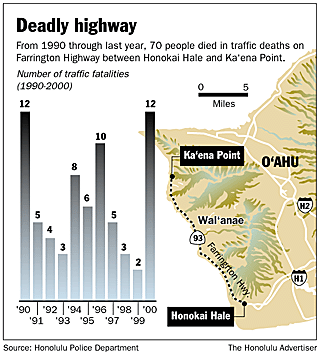By James Gonser
Advertiser Leeward Bureau
WAI‘ANAE — Seventy is just a number, and not an especially big one.
But when 70 is a death count, it suddenly looks much larger.
From 1990 through last year, 70 people have lost their lives in traffic accidents on Farrington Highway between Honokai Hale and Ka‘ena Point, statistically one of the most dangerous stretches of asphalt in the state.
Wai‘anae High School teacher Candy Suiso lost a nephew in a 1996 car accident. He was 12 years old.
"We all feel the pain. We really feel the pain," Suiso said. "It has been just one after the other out here in Wai‘anae. We knew some of these families and then when it hit our family, it was just awful. Everyone out here is connected to a death somehow."
Last year, 12 of O‘ahu’s 66 traffic fatalities were in Wai‘anae, the worst year for the area since 1990, when there were also 12 traffic deaths.
Why there are so many deadly accidents along the coast and how to prevent them has been debated for years. But now the community of 45,000 is trying to pull together to help grieving families heal.
The Wai‘anae Coast Coalition and the Honolulu Police Department held a candlelight vigil Nov. 25 at Ma‘ili Beach Park to remember those who died.
About 100 people attended, many of them silent, simply sharing their grief.
Lyn Worley, who helped organize the vigil, said it was very emotional for the participants.
"It gave people a chance to talk and burn candles for anything they needed to shed light on," Worley said. "It offered them a chance to grieve publicly and begin to heal."
Deaths shake families to the core
Judi Wilson, executive director of the Hawai‘i chapter of Mothers Against Drunk Driving, said it is her experience that traffic deaths shake families to the core.
"It affects the balance in their lives," Wilson said. "We find that often initially they experience shock, denial or disbelief, then anger and depression.
"It may take quite a while for that all-consuming feeling of sadness to let up some. It eventually can diminish, but they do mourn this loss of life, for life. Nothing will bring back their loved one."
Holding signs that said "Speed kills," "Slow down," and "Got brakes?" hundreds of coast residents took part in HPD’s annual "Live and Let Live" traffic safety campaign during the holidays.
Residents and police officers stationed themselves at Nanakuli Beach Park, Ma‘ili Point and the Wai‘anae Boat Harbor near displays of cars that have been wrecked in traffic accidents as vivid examples of the results of speeding.
Officer Avery Choy said six of the fatalities last year were pedestrians and two of the accidents were alcohol related. She hopes seeing the crashed cars will have an effect on drivers.
"How do we measure its effectiveness? If people are aware about the program and talk about it, then it is having an effect," Choy said.
Wai‘anae resident Cynthia Rezentes said she has recently seen people change their driving habits because of the number of accidents.
"There are times on Farrington Highway when I get behind people driving the speed limit now where before I didn’t see that much," Rezentes said. "One woman who knew two or three people killed in a couple months does not even drive in the fast lane anymore."
But Rezentes said some steps taken to reduce speeding have backfired. She said adding more stop lights along the highway has, in some cases, made drivers more impatient as they speed ahead to make green lights.
"It’s frustrating not knowing what can be done to help not have these deaths," Rezentes said. "Part of it is the people themselves. Part of it is we have to make sure our roads are engineered so that they are designed for safety as much as possible, but if people are going to drive 50, 60, 70 miles per hour on a road designed for 25 mph, something is going to happen and it is not going to be good."
"Roads not at fault'
State Department of Transportation traffic safety engineer Alvin Takeshita said, "That stretch (of Farrington Highway) has some of the most severe accidents, and we suspect many have driver-related factors — speeding, impairment," Takeshita said. "The roads are not at fault, it is usually the drivers."
Sen. Colleen Hanabusa (D-Barbers Point-Makaha) says the community is frustrated because the government has not found a solution.
"The community itself is split on what the solution is," Hanabusa said.
Hanabusa suggested the types of accidents be scrutinized and solutions for specific problems be addressed.
"We all know there is a problem at Ma‘ili Point," Hanabusa said. "Some of us feel it is a matter of enforcement. When the police officers are on the road, things seem to be fine. When they are not there, and it is impossible for them to be there all the time, that’s when people speed."
District 8 (Wai‘anae-Kapolei) police commander Maj. Alan Fujimoto said he is working with the department’s traffic division to enforce speeding laws, using unmarked vehicle as spotters while solo bike officers pull over violators and issue citations.
"As much as possible, we are having patrol officers go out with lasers, manpower permitting, doing stationary enforcement," Fujimoto said. "It has been somewhat effective in the Ma‘ili area."
Hanabusa said regardless of the reasons, 70 traffic deaths since 1990 is too many.
"We are talking about one community," she said. "I think that is a huge number."
[back to top] |

